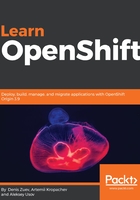
Installing and working with CRI-O
It's time to get hands-on with CRI-O. We are not going to explore CRI-O in depth, but rather show you how to bring up a development environment with CRI-O configured with some basic functionality.
In order to start Kubernetes with CRI-O as a Container Runtime Interface, we are going to use Minikube with an additional --container-runtime crio option:
$ minikube start --container-runtime crio
Starting local Kubernetes v1.9.0 cluster...
...
<output omitted>
...
Loading cached images from config file.
Check Minikube's status and make sure that it is up and running:
$ minikube status
minikube: Running
cluster: Running
kubectl: Correctly Configured: pointing to minikube-vm at 192.168.99.106
It looks pretty standard, but if we take a look at the Minikube logs, we will see that Minikube is initializing CRI-O Runtime:
$ minikube logs | grep cri-o
Jul 08 21:11:36 minikube localkube[3098]: I0708 21:11:36.333484 3098 kuberuntime_manager.go:186] Container runtime cri-o initialized, version: 1.8.4, apiVersion: v1alpha1
Let's create a pod using a Docker image with the kubectl run command:
$ kubectl run httpd --image=docker.io/httpd
deployment "httpd" created
Wait for a minute or so while Kubernetes Note downloads the httpd image and then verify that we have a httpd pod up and running:
$ kubectl get pods
NAME READY STATUS RESTARTS AGE
httpd-7dcb9bd6c4-x5dhm 1/1 Running 0 4m
Again, from this point of view, it looks pretty standard, but if we run the kubectl describe command, we will see that the container ID starts with cri-o://:
$ kubectl describe pods/httpd-7dcb9bd6c4-x5dhm
Name: httpd-7dcb9bd6c4-x5dhm
...
<output omitted>
...
IP: 10.1.0.4
Container ID: crio://3f2c2826318f1526bdb9710050a29b5d4a3de78d61e0...
Image: docker.io/httpd
...
<output omitted>
...
At this point, this shows us that Kubernetes is using the CRI-O runtime interface. This means that Kubernetes is talking to CRI-O. CRI-O (the crio daemon, to be specific) is handling the image pulling and container creating processes. Let's verify this by running the docker images and docker ps commands inside the Minikube VM:
$ minikube ssh docker images
REPOSITORY TAG IMAGE ID CREATED SIZE
gcr.io/k8s-minikube/storage-provisioner v1.8.0 4689081edb10 4 months ago 80.8MB
$ minikube ssh docker ps
CONTAINER ID IMAGE COMMAND CREATED STATUS PORTS NAMES
As you can see, there are no images or containers named httpd. We mentioned earlier that CRI-O is using runc Container Runtime behind the scenes. To help us further with the verification process, we are going to use the runc command inside the Minikube VM. runc is a CLI command for running containers packaged according to the OCI format. The syntax of the runc command is very similar to the docker command we used in Chapter 1, Containers and Docker Overview.
$ minikube ssh "sudo runc ps \
3f2c2826318f1526bdb9710050a29b5d4a3de78d61e07ac9d83cedb9827c62e4"
UID PID PPID C STIME TTY TIME CMD
root 5746 5695 0 02:39 ? 00:00:00 httpd -DFOREGROUND
daemon 5788 5746 0 02:39 ? 00:00:00 httpd -DFOREGROUND
daemon 5792 5746 0 02:39 ? 00:00:00 httpd -DFOREGROUND
daemon 5793 5746 0 02:39 ? 00:00:00 httpd -DFOREGROUND